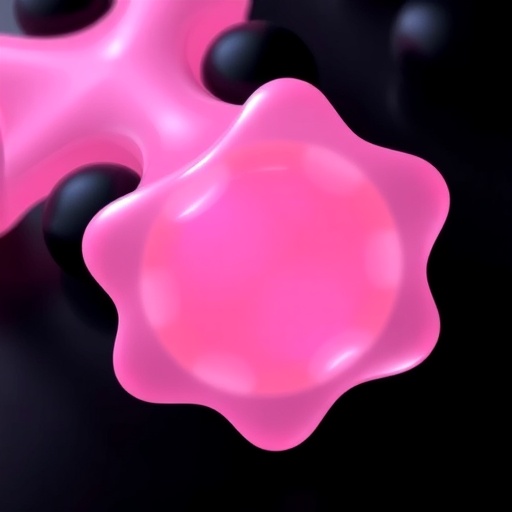In a groundbreaking advancement poised to revolutionize materials science and biomedical applications, researchers have unveiled a data-driven approach to designing super-adhesive hydrogels. These cutting-edge materials promise unprecedented underwater adhesion, potentially transforming fields ranging from tissue engineering to marine technology. By harnessing a fusion of chemical synthesis, bioinformatics, and machine learning, the team achieved an intelligent, iterative framework to de novo design hydrogels with exceptional adhesive strength.
The foundation of this breakthrough lies in a meticulously engineered synthesis process, wherein multiple functional monomers were copolymerized in a single step via free-radical polymerization. By fine-tuning the ratio of chemical crosslinkers relative to monomer content, the researchers optimized each hydrogel’s balance of elasticity and deformability. Notably, gels were synthesized using dimethyl sulfoxide (DMSO) solutions containing functional monomers at a high total molarity, ensuring robust polymer networks amenable to adhesive functionality. Ultraviolet (UV) irradiation initiated polymerization, achieving nearly complete monomer conversion within hours.
Following synthesis, the organogel precursors were immersed in physiological saline solutions to remove residual solvents and unreacted chemicals, stabilizing the hydrogels into their functional aqueous states. This meticulous post-processing step not only ensured biocompatibility but also locked in the gels’ swelling equilibrium. Storage in saline stabilized the materials, setting the stage for precise adhesion characterization under reproducible conditions.
To quantitatively assess adhesion, the team employed a battery of mechanical tests, including tack assays and lap shear measurements, conducted entirely underwater to simulate real-world conditions pertinent to biomedical and marine interfaces. Adhesion tests utilized custom instrumentation calibrated for gentle yet firm application of forces, ensuring accurate measurement of adhesive strength without overstressing the materials. Repeated attachment-detachment cycles highlighted the hydrogels’ remarkable durability, while peeling assays characterized interfacial toughness — a critical parameter for applications demanding sustained adhesion.
The design strategy extended beyond traditional polymer chemistry, incorporating a large-scale bioinformatics effort to decode adhesive protein sequences from nature. By mining over 24,000 adhesive protein sequences across thousands of species, the researchers generated consensus sequences that distilled the most conserved and functionally relevant motifs. This natural blueprint guided monomer selection and formulation parameters, creating synthetic hydrogels inspired yet optimized beyond biological templates.
Central to the endeavor was the implementation of sophisticated machine learning (ML) techniques to correlate hydrogel composition with adhesive performance. Six key monomers defined a multidimensional feature space, within which adhesive strength served as the target variable. The team exhaustively evaluated a suite of linear and non-linear regression models, including ridge regression, support vector machines, Gaussian processes, and ensemble tree methods. Cross-validation identified Gaussian process regression and random forest algorithms as the most accurate predictors.
Yet, the true power of the ML integration manifested in the iterative, closed-loop optimization of hydrogel formulations. By leveraging Bayesian optimization strategies, the researchers navigated the vast compositional space with both exploitation of known high-performing areas and exploration of uncharted territories. This included batch evaluations of predicted compositions, and the use of hybrid surrogate models that dynamically balanced the uncertainty and expected improvements in adhesion. Such sampling efficiency was critical given the protracted two-week synthesis and equilibration times inherent to hydrogel fabrication.
Through successive rounds of prediction, synthesis, and validation, the data set expanded from an initial 180 hydrogels to over 340 unique formulations. This expansive dataset not only enhanced model fidelity but also unearthed novel compositions exhibiting adhesion strengths surpassing those of natural protein adhesives. The approach demonstrated a powerful paradigm for material discovery by marrying high-dimensional data analytics with experimental rigor.
This research sets a precedent for smart material design, showcasing how integrating bioinspired heuristics and advanced algorithms can circumvent traditional trial-and-error limitations. The resultant super-adhesive hydrogels possess tunable mechanical and adhesive properties, opening avenues for wound closure materials, underwater repair adhesives, and bioelectronic interfaces. Their stability under physiological saline and repeated mechanical stress further underscores their translational potential.
Moreover, this work illuminates the utility of consensus sequence analysis in translating complex biological information into actionable design variables for synthetic systems. By bridging disciplines — polymer chemistry, bioinformatics, and machine learning — the study exemplifies the power of interdisciplinary strategies in addressing formidable scientific challenges.
The meticulous characterization protocols established herein provide a reproducible framework for future studies targeting material adhesion phenomena. Standardized testing parameters, including contact times, loading rates, and environmental conditions, enable rigorous comparison across samples and formulations. Such precision ensures that improvements in performance are due to intrinsic material properties rather than measurement artifacts.
Intriguingly, the study’s machine learning methodology incorporated not only predictive modeling but also uncertainty quantification, facilitating strategic experimentation that maximized information gain. Techniques such as expected improvement acquisition functions allowed for efficient prioritization of formulations to synthesize, minimizing wasted effort and accelerating discovery cycles.
In sum, this research presents a compelling vision for the future of material innovation, where intelligent algorithms guide molecular design toward unprecedented capabilities. The capacity to customize adhesion properties precisely and rapidly, even under challenging conditions like underwater environments, is poised to impact a host of technological domains. Ongoing and future exploration informed by this work may well redefine what is achievable in synthetic adhesives.
Subject of Research: Data-driven design and synthesis of super-adhesive hydrogels inspired by adhesive proteins.
Article Title: Data-driven de novo design of super-adhesive hydrogels.
Article References:
Liao, H., Hu, S., Yang, H. et al. Data-driven de novo design of super-adhesive hydrogels. Nature 644, 89–95 (2025). https://doi.org/10.1038/s41586-025-09269-4
Image Credits: AI Generated




